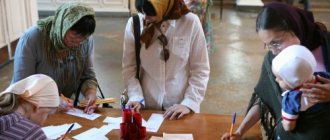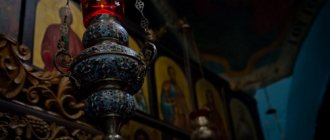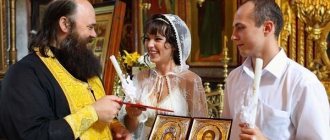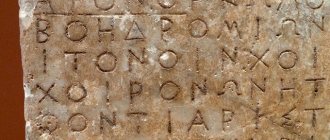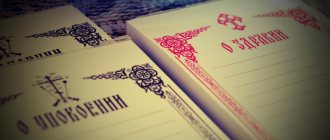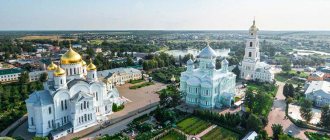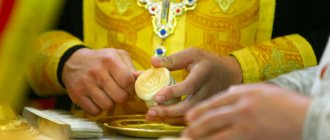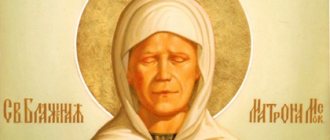The special power of congregational prayer
A temple is the house of God on Earth, where believers gather for common (congregational) prayer. Jesus Christ said: “Truly I also say to you that if two of you agree on earth about anything they ask, it will be done for them by My Father who is in heaven. For where two or three are gathered together in My name, there I am.” in the midst of them” (Matthew 18:19-20). Therefore, every Orthodox Christian strives to prayerfully remember his loved ones not only in home prayer, but also in church, where God and the grace of God are invisibly present. Health notes allow this to be done.
Notes on health
Prosphora at the proskomedia
During a church service, at least five special loaves , which are otherwise called prosphora. They all have their purpose.
From the first, largest, the priest cuts out a part in the form of a cube and places it on a special dish - paten. This part symbolizes the sacrificial Lamb, and it is this part that is later distributed among the participants.
The second prosphora is called the Mother of God; a triangular particle is taken out of it in honor of the Virgin Mary.
From the third prosphora, called the nine-order prosphora, nine particles are cut out, symbolizing the saints: John the Baptist, apostles and prophets, martyrs and unmercenaries, saints and saints, Joachim and Anna, as well as the saint in whose name the Liturgy is celebrated.
The fourth prosphora is used to extract particles about the living - the patriarch and clergy. From the fifth prosphora, particles of the deceased are extracted.
Then the clergyman moves on to the small prosphora served by the parishioners. A very important stage of service begins.
Most likely, you will need information about what to give a boy for christening.
Notes on health
In the Russian Orthodox Church, notes on health and repose have become widespread. Almost everyone knows about them and uses them. Both people close to the Orthodox faith and those who occasionally come into the church to light candles and submit notes. A church note is a type of prayer for the living (for health) and for the dead (for repose). This prayer is performed in the temple by a priest and has a special grace-filled power.
Notes can be divided into two types. The first is those that are read during the Divine Liturgy. The second type is those whose names are commemorated during prayers and memorial services.
Notes read at the Liturgy are often called “for proskomedia.” During the first part of the Liturgy, the proskomedia, the priest takes particles from the prosphora and pronounces the names from the notes. These particles will subsequently be immersed in the Communion Chalice with the words:
“Wash away, O Lord, the sins of those who were remembered here by Thy honest Blood, by the prayers of Thy saints.”
Such commemoration is very important; it occurs during the Liturgy, the Savior’s offering of Himself as a bloodless Sacrifice for all people.
The second type of notes is a prayerful remembrance of loved ones at prayer services and memorial services. Prayers are “thanksgiving” to the Lord, and are also performed in front of an icon of the Mother of God or a saint. So, for example, for people suffering from drunkenness and other addictions, a water-blessing prayer service is often served in front of the icon of the Mother of God “The Inexhaustible Chalice”.
Symbolism of Proskomedia
This service is performed at the altar. Those in the church do not see how this happens - this is the first symbol: the secrecy of the action recalls the secrecy of the Nativity of Christ, which took place in a cave unknown and invisible to the world.
Prosphora for the sacrament. The whole action is performed over five liturgical prosphoras. After reading special prayers, the priest cuts out the center of one of them in the form of a cube. This part of the prosphora is called the Lamb and symbolizes the Savior himself, sacrificed to the slaughter.
A round dish standing on a stand is called a paten and is also a symbol of the manger where the newborn God-infant was placed. The “lamb” prosphora is placed on the paten. It is this part of the prosphora that will be used during Communion.
Particles are removed from the remaining four “bread loaves”:
- in honor of the Virgin Mary,
- in honor of John the Baptist, prophets, apostles and all saints,
- about the health of church hierarchs - from the Patriarch to the deacons,
- about the repose of the same ranks, including the deceased founders of temples.
Prosphora on the paten.
All the particles taken from the prosphoras are laid out on the paten in a certain order, as if surrounding the Lamb: to the left of him is the “Virgin” particle; on the right are nine “saintly” particles; below - for living clergy, and even lower - for the deceased. Following this, the priest begins the usual prosphora. After reading each name indicated in the note, he takes out a piece with the words: “Remember, Lord, (name).”
Thus, if a person submitted notes on a candle box for a proskomedia, he can be sure: those whose names are written in them, although invisible to those praying, have already been remembered.
The particles taken out according to the notes of the parishioners are also placed on the paten - next to those taken from the five liturgical prosphoras. Lying on the paten in this order, they are a symbol of the entire Church of Christ.
How to write health notes correctly
It is important to understand that only people baptized in the Orthodox faith can be commemorated in Temples. You should pray for those who are not baptized at home (consult a priest in church on this issue).
It is best to submit notes before the start of the Liturgy or the night before. Notes should be written in legible handwriting to make them easier to read.
An eight-pointed cross is usually drawn at the very top. Next it is written “for health” or “for peace.” Under these inscriptions the names of baptized Christians are listed in the genitive case.
If the notes contain the names of clergy, then you need to write the rank before the name: for example, Priest Demetrius. “Baby” is written before the names of children under seven years of age. You can also mention before the name: “sick”, “seriously ill”, “travelling”, “monk”, “warrior”, “prisoner”. No other information about the person is indicated in the notes (position, surname, patronymic, degree of relationship).
The absence of a name in the Saints is not a reason for refusing to remember. Not all Orthodox churches have a tradition of naming names in honor of saints.
Take, for example, the Georgian Church. The rector of the Church of the Holy Great Martyr George the Victorious - the Patriarchal Metochion in Gruziny - Archpriest Fyodor Krechetov tells how names are given in Baptism:
“In Georgia, babies are mostly given names at baptism in honor of saints. But other traditional Georgian names can also be given. The basis for this custom can be considered the following fact: on December 24/11, the Georgian Church celebrates the memory of All Georgian Saints. Among them, we remember the 100 thousand martyrs who suffered from the Khorezm Shah Jalal ad-din in the 13th century. It is clear that all their names have not been preserved. And this gives the right to call children by names that are not in the month book.”
Commemoration at the Proskomedia
Before the start of the service, believers submit notes in which they indicate the names of people to be commemorated. The priest reads them out loud, for each name a part is taken out of the prosphora, and the prayer is said: “Remember, Lord, the name is called.” Each such particle symbolizes the soul of the person indicated in the note and, together with particles from the liturgical prosphora, is placed on the paten. These particles are not used in communion, but at the end of the Liturgy they are dipped into wine, which means washing from sins, cleansing.
It turns out that the particles taken out for the people mentioned in the notes participate in the worship service. Therefore, such commemoration is considered a very important, strong prayer, which provides great help to the soul.
It is important to understand what a proskomedia for health and a proskomedia for repose are. For each of them, separate notes are submitted with the names of living or deceased Orthodox Christians. Commemoration of health can be ordered not only for a sick person, but also for health in the broad sense of the word - for peace of mind, for peace and well-being, and, first of all, for the salvation of the soul. Proskomedia for the repose is intended to alleviate the afterlife fate of the deceased who can no longer give alms or repent, so they need the help of the living.
Submit notes - don’t forget to pray
It is important to understand that the very fact of “submitting” a note does not negate the need to independently pray for the people listed on paper. The priest should pray for your loved ones. But you yourself must certainly attend the service and offer prayer to God.
Paisius the Svyatogorets was once asked:
“- Geronda, some people write notes with the names of the sick and send them to different monasteries for commemoration.
– This is good, but not enough. People themselves should pray and tell the sick to pray too. You don’t have to be content with just sending out names” (From the book “Words. Prayer”).
About health and peace
The priest’s answer will best illuminate the proskomedia. Archpriest Dimitri explains:
— Those who attend church, receiving or buying prosphora, see that it seems to have been pecked. These are traces of the removal of its particles during proskomedia. Typically, notes to this service are submitted about health and repose. And at this service both living and departed Christians are remembered. Let me note by the way: only baptized Orthodox Christians are commemorated. In this ritual they do not pray for those of other faiths, so their names do not need to be included in the note for the proskomedia.
Notes with names should be given in advance.
Liturgy, all the crumbs taken from the prosphora, symbolizing the commemorated souls and collected at the paten, are immersed in a cup of wine with a special prayer.
The text of the prayer contains a request to Jesus Christ to cleanse the sins of the Christians mentioned in the notes with His Blood shed for the sins of the whole world. This is considered a bloodless sacrifice and is the highest church commemoration.
Since the proskomedia takes place before the main service, such notes must be submitted long before it begins, preferably the day before, indicating the required date.
Note on proskomedia
Usually at the candle counter you can take special forms on which a cross is depicted and the heading is written - “On health” or “On repose”. If there are no forms, then there will definitely be blank sheets of paper on which you should draw a cross yourself and write a title. You need to be careful not to confuse the headings.
The same rules apply for notes for a proskomedia as for notes for a mass or memorial service. Names are written in a column, in the genitive case, in full. You should write the name that was given at baptism; it may differ from what is on the documents. For example, not Ivan, but John, not Svetlana, but Photinia. A woman officially bearing the name Olesya can be baptized as either Olga or Alexandra. Therefore, it is necessary to know exactly the church names of people.
You cannot indicate suicides, unbaptized people, or people of other faiths . The names of clergy should be written indicating their rank, it is advisable to write them down first. Children under the age of seven are indicated as infants, from seven to fourteen years old - as adolescents (or young women). In addition, such clarifications as “sick”, “traveling”, “warrior”, “prisoner” are acceptable in the list for commemoration of health. Pregnant women can be recorded as “fertile.” Here is an example of a health note:
- Archpriest Victor;
- Gennady.
- sick Tatiana;
- baby Mary;
- traveling John;
- the youth of Anna.
The following clarifications are allowed in the funeral note: “warrior”, “killed”, “of ever-memorable” (indicated if the service takes place on the name day or death of the deceased). For forty days after death, the deceased is called newly deceased. For example, like this:
- the ever-memorable Theodore;
- Olga.
- newly deceased Evdokia;
- warrior Sergius.
The notes themselves for the proskomedia may not differ in any way from the notes for a mass or requiem; it is enough to write them separately, and then tell the minister of the church shop that they are intended specifically for the proskomedia.

